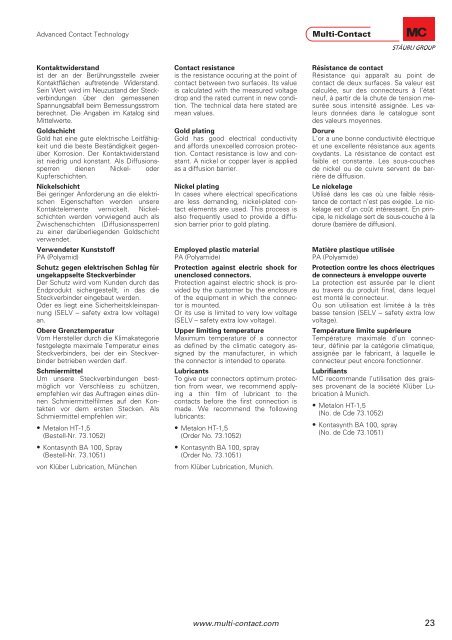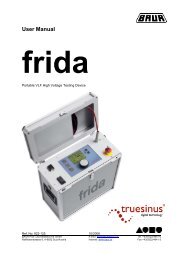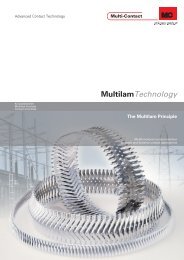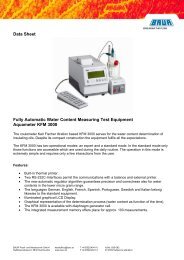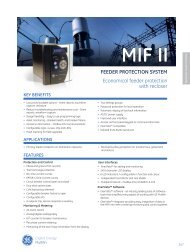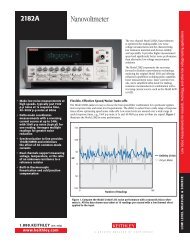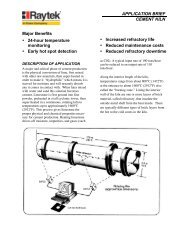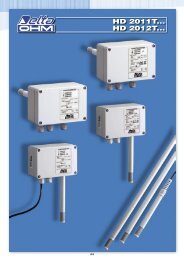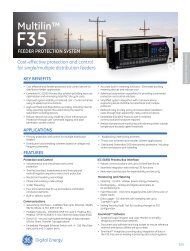Miniline - Belmet
Miniline - Belmet
Miniline - Belmet
Create successful ePaper yourself
Turn your PDF publications into a flip-book with our unique Google optimized e-Paper software.
Advanced Contact Technology<br />
Kontaktwiderstand<br />
ist der an der Berührungsstelle zweier<br />
Kontaktflächen auftretende Widerstand.<br />
Sein Wert wird im Neuzustand der Steckverbindungen<br />
über den gemessenen<br />
Spannungsabfall beim Bemessungsstrom<br />
berechnet. Die Angaben im Katalog sind<br />
Mittelwerte.<br />
Goldschicht<br />
Gold hat eine gute elektrische Leitfähigkeit<br />
und die beste Beständigkeit gegenüber<br />
Korrosion. Der Kontaktwiderstand<br />
ist niedrig und konstant. Als Diffusionssperren<br />
dienen Nickel- oder<br />
Kupferschichten.<br />
Nickelschicht<br />
Bei geringer Anforderung an die elektrischen<br />
Eigenschaften werden unsere<br />
Kontaktelemente vernickelt. Nickelschichten<br />
werden vorwiegend auch als<br />
Zwischenschichten (Diffusionssperren)<br />
zu einer darüberliegenden Goldschicht<br />
verwendet.<br />
Verwendeter Kunststoff<br />
PA (Polyamid)<br />
Schutz gegen elektrischen Schlag für<br />
ungekappselte Steckverbinder<br />
Der Schutz wird vom Kunden durch das<br />
Endprodukt sichergestellt, in das die<br />
Steckverbinder eingebaut werden.<br />
Oder es liegt eine Sicherheitskleinspannung<br />
(SELV – safety extra low voltage)<br />
an.<br />
Obere Grenztemperatur<br />
Vom Hersteller durch die Klimakategorie<br />
festgelegte maximale Temperatur eines<br />
Steckverbinders, bei der ein Steckverbinder<br />
betrieben werden darf.<br />
Schmiermittel<br />
Um unsere Steckverbindungen bestmöglich<br />
vor Verschleiss zu schützen,<br />
empfehlen wir das Auftragen eines dünnen<br />
Schmiermittelfilmes auf den Kontakten<br />
vor dem ersten Stecken. Als<br />
Schmiermittel empfehlen wir:<br />
• Metalon HT-1,5<br />
(Bestell-Nr. 73.1052)<br />
• Kontasynth BA 100, Spray<br />
(Bestell-Nr. 73.1051)<br />
von Klüber Lubrication, München<br />
Contact resistance<br />
is the resistance occuring at the point of<br />
contact between two surfaces. Its value<br />
is calculated with the measured voltage<br />
drop and the rated current in new condition.<br />
The technical data here stated are<br />
mean values.<br />
Gold plating<br />
Gold has good electrical conductivity<br />
and affords unexcelled corrosion protection.<br />
Contact resistance is low and constant.<br />
A nickel or copper layer is applied<br />
as a diffusion barrier.<br />
Nickel plating<br />
In cases where electrical specifications<br />
are less demanding, nickel-plated contact<br />
elements are used. This process is<br />
also frequently used to provide a diffusion<br />
barrier prior to gold plating.<br />
Employed plastic material<br />
PA (Polyamide)<br />
Protection against electric shock for<br />
unenclosed connectors.<br />
Protection against electric shock is provided<br />
by the customer by the enclosure<br />
of the equipment in which the connector<br />
is mounted.<br />
Or its use is limited to very low voltage<br />
(SELV – safety extra low voltage).<br />
Upper limiting temperature<br />
Maximum temperature of a connector<br />
as defined by the climatic category assigned<br />
by the manufacturer, in which<br />
the connector is intended to operate.<br />
Lubricants<br />
To give our connectors optimum protection<br />
from wear, we recommend applying<br />
a thin film of lubricant to the<br />
contacts before the first connection is<br />
made. We recommend the following<br />
lubricants:<br />
• Metalon HT-1,5<br />
(Order No. 73.1052)<br />
• Kontasynth BA 100, spray<br />
(Order No. 73.1051)<br />
from Klüber Lubrication, Munich.<br />
Résistance de contact<br />
Résistance qui apparaît au point de<br />
contact de deux surfaces. Sa valeur est<br />
calculée, sur des connecteurs à I’état<br />
neuf, à partir de la chute de tension mesurée<br />
sous intensité assignée. Les valeurs<br />
données dans le catalogue sont<br />
des valeurs moyennes.<br />
Dorure<br />
L’or a une bonne conductivité électrique<br />
et une excellente résistance aux agents<br />
oxydants. La résistance de contact est<br />
faible et constante. Les sous-couches<br />
de nickel ou de cuivre servent de barrière<br />
de diffusion.<br />
Le nickelage<br />
Utilisé dans les cas où une faible résistance<br />
de contact n’est pas exigée. Le nickelage<br />
est d’un coût intéressant. En principe,<br />
le nickelage sert de sous-couche à la<br />
dorure (barrière de diffusion).<br />
Matière plastique utilisée<br />
PA (Polyamide)<br />
Protection contre les chocs électriques<br />
de connecteurs à enveloppe ouverte<br />
La protection est assurée par le client<br />
au travers du produit final, dans lequel<br />
est monté le connecteur.<br />
Ou son utilisation est limitée à la très<br />
basse tension (SELV – safety extra low<br />
voltage).<br />
Température limite supérieure<br />
Température maximale d’un connecteur,<br />
définie par la catégorie climatique,<br />
assignée par le fabricant, à laquelle le<br />
connecteur peut encore fonctionner.<br />
Lubrifiants<br />
MC recommande l’utilisation des graisses<br />
provenant de la société Klüber Lubrication<br />
à Munich.<br />
• Metalon HT-1,5<br />
(No. de Cde 73.1052)<br />
• Kontasynth BA 100, spray<br />
(No. de Cde 73.1051)<br />
www.multi-contact.com 23


